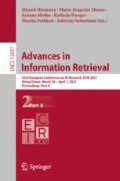Abstract
Fake news, a deliberately designed news to mislead others, is becoming a big societal threat with its fast dissemination over the Web and social media and its power to shape public opinion. Many researchers have been working to understand the underlying features that help identify these fake news on the Web. Recently, Horne and Adali found, on a small amount of data, that news title stylistic and linguistic features are better than the same type of features extracted from the news body in predicting fake news. In this paper, we present our attempt to reproduce the same results to validate their findings. We show which of their findings can be generalized to larger political and gossip news datasets.
Access this chapter
Tax calculation will be finalised at checkout
Purchases are for personal use only
Notes
- 1.
Repetitive language is measured by using the Type-Token Ratio (TTR) which is the number of unique words in the document by the total number of words in the document. A low TTR means more repetitive language, while a high TTR means more lexical diversity. Horne and Adali claim fake news has more repetitive language but show the opposite result in their paper, i.e., TTR is on average higher for fake than real news (cf. Table 4 in [7]), indicating more lexical diversity for fake than real news. Our results confirms more lexical diversity for fake news as shown in Table 2.
- 2.
- 3.
- 4.
- 5.
The BuzzFeedNews dataset is available at https://zenodo.org/record/1239675#.X5riw0JKgXA.
- 6.
- 7.
The NRC-EIL lexicon should be downloaded at https://www.saifmohammad.com/WebPages/AffectIntensity.htm.
References
Bird, S.: NLTK: the natural language toolkit. In: Proceedings of the COLING/ACL on Interactive Presentation Sessions, pp. 69–72 (2006)
Burfoot, C., Baldwin, T.: Automatic satire detection: are you having a laugh? In: Proceedings of the ACL-IJCNLP 2009 Conference Short Papers, pp. 161–164 (2009)
Devlin, J., Chang, M.W., Lee, K., Toutanova, K.: Bert: pre-training of deep bidirectional transformers for language understanding. arXiv preprint arXiv:1810.04805 (2018)
Ghanem, B., Rosso, P., Rangel, F.: An emotional analysis of false information in social media and news articles. ACM Trans. Internet Technol. (TOIT) 20(2), 1–18 (2020)
Gilbert, C., Hutto, E.: Vader: A parsimonious rule-based model for sentiment analysis of social media text. In: Eighth International Conference on Weblogs and Social Media (ICWSM 2014), vol. 81, p. 82 (2014)
Hills, T.T.: The dark side of information proliferation. Perspect. Psychol. Sci. 14(3), 323–330 (2019)
Horne, B.D., Adali, S.: This just in: fake news packs a lot in title, uses simpler, repetitive content in text body, more similar to satire than real news. In: The 2nd International Workshop on News and Public Opinion at ICWSM (2017)
Milton, A., Batista, L., Allen, G., Gao, S., Ng, Y., Pera, M.S.: “Don’t judge a book by its cover”: exploring book traits children favor. In: RecSys 2020: Fourteenth ACM Conference on Recommender Systems, Virtual Event, Brazil, 22–26 September 2020, pp. 669–674. ACM (2020)
Mohammad, S.: Word affect intensities. In: Proceedings of the Eleventh International Conference on Language Resources and Evaluation (LREC 2018), Miyazaki, Japan, 7–12 May 2018 (2018)
Pennebaker, J.W., Boyd, R.L., Jordan, K., Blackburn, K.: The development and psychometric properties of LIWC2015. Technical report (2015)
Pérez-Rosas, V., Kleinberg, B., Lefevre, A., Mihalcea, R.: Automatic detection of fake news. In: Proceedings of the 27th International Conference on Computational Linguistics, pp. 3391–3401 (2018)
Potthast, M., Kiesel, J., Reinartz, K., Bevendorff, J., Stein, B.: A stylometric inquiry into hyperpartisan and fake news. In: Proceedings of the 56th Annual Meeting of the Association for Computational Linguistics, ACL 2018, Melbourne, Australia, 15–20 July 2018, Volume 1: Long Papers, pp. 231–240 (2018)
Shearer, E., Grieco, E.: Americans are wary of the role social media sites play in delivering the news (2019)
Shrestha, A., Spezzano, F., Gurunathan, I.: Multi-modal analysis of misleading political news. In: van Duijn, M., Preuss, M., Spaiser, V., Takes, F., Verberne, S. (eds.) MISDOOM 2020. LNCS, vol. 12259, pp. 261–276. Springer, Cham (2020). https://doi.org/10.1007/978-3-030-61841-4_18
Shu, K., Mahudeswaran, D., Wang, S., Lee, D., Liu, H.: Fakenewsnet: a data repository with news content, social context, and spatiotemporal information for studying fake news on social media. Big Data 8(3), 171–188 (2020)
Shu, K., Sliva, A., Wang, S., Tang, J., Liu, H.: Fake news detection on social media: a data mining perspective. ACM SIGKDD Explor. Newsl. 19(1), 22–36 (2017)
Thelwall, M., Buckley, K., Paltoglou, G., Cai, D., Kappas, A.: Sentiment strength detection in short informal text. J. Am. Soc. Inform. Sci. Technol. 61(12), 2544–2558 (2010)
Zimdars: False, misleading, clickbait-y, and satirical news sources (2016). https://docs.google.com/document/d/10eA5-mCZLSS4MQY5QGb5ewC3VAL6pLkT53V_81ZyitM/preview
Acknowledgements
This work has been supported by the National Science Foundation under Award no. 1943370. We thank Ashlee Milton and Maria Soledad Pera for providing us the code used in their paper [8] to compute emotional features.
Author information
Authors and Affiliations
Corresponding author
Editor information
Editors and Affiliations
Rights and permissions
Copyright information
© 2021 Springer Nature Switzerland AG
About this paper
Cite this paper
Shrestha, A., Spezzano, F. (2021). Textual Characteristics of News Title and Body to Detect Fake News: A Reproducibility Study. In: Hiemstra, D., Moens, MF., Mothe, J., Perego, R., Potthast, M., Sebastiani, F. (eds) Advances in Information Retrieval. ECIR 2021. Lecture Notes in Computer Science(), vol 12657. Springer, Cham. https://doi.org/10.1007/978-3-030-72240-1_9
Download citation
DOI: https://doi.org/10.1007/978-3-030-72240-1_9
Published:
Publisher Name: Springer, Cham
Print ISBN: 978-3-030-72239-5
Online ISBN: 978-3-030-72240-1
eBook Packages: Computer ScienceComputer Science (R0)

